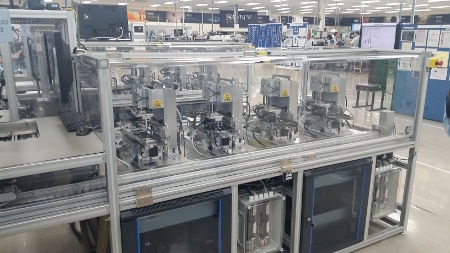Visit to Sony Raspberry Pi Factory Wales
I’ve recently been to visit the Sony UK factory where the Raspberry Pi is made. This was made possible thanks to RS Components and a competition to win a tour around the site.
The site known as the Sony UK Technology Centre is based in Pencoed Wales. At the site they manufacture high-end video cameras used in the broadcasting industry, it is also a Sony customer service repair centre and along with the Raspberry Pi they perform manufacturing for other companies.
Factory tour
Much of the manufacturing is fully automated. The line that we went along was adding components to the second side of the board. The boards had solder applied through a mask and then the SMT (Surface Mount Technology) components placed using pick and place machines such as the machine below:

The boards then go through an oven where the solder is melted attaching the components to the board.

After automated testing of the solder joints the Raspberry Pi boards are ready for the final components to be inserted by hand (the chunky bits like the Ethernet and USB connectors) which are then soldered by machine.
The finished boards were then tested using this impressive testing jig created by Sony specifically for the Raspberry Pi.

The testing stage was the part that impressed me the most as that is something that is often done by hand due to the complexity and unique nature. In this case though the testing was performed much faster than could possibly be achieved by hand.

We also got to see how a robot is being trained to help with some of the components that are currently inserted by hand. Contrary to some of the scare stories this was not a case of people getting the sack to make the way for robots. The robots were making the process more efficient and increasing the number of Raspberry Pis that were being made, which then makes the staff available to perform tasks where they could provide more value-add. Robots and humans working side-by-side to build Raspberry Pis.
I see this as a positive thing as it means that manufacturing can be done in the same country as the computer was designed. Without the level of automation achieved then it’s hard to see how manufacturing can survive in countries like the UK where the cost of workforce is relatively high. It also provides other jobs in the local area included in the supply chain.
Pi-Top
During the afternoon we then got to have a go with the Pi-Top and Pi-Top CEED, which are laptops and computers based around the Raspberry Pi.

This was run as an educational activity where we got to experience the education software (which they are currently getting certified through OCR) and then to program Minecraft in Python. This finished with a programming challenge where we were challenged with creating a sculpture in Minecraft combining art and programming. I created a flashing lighthouse using Python to switch between diamond and air blocks to make the flashing light.
After a close run vote I won first prize which was my very own Pi-Top! I’ll be writing more about the Pi-Top in the future and plan to take it along to some future STEM Ambassador activities I’m involved with.
Thank You
I really enjoyed visiting the factory. A big thank you to all those involved in the day including:
